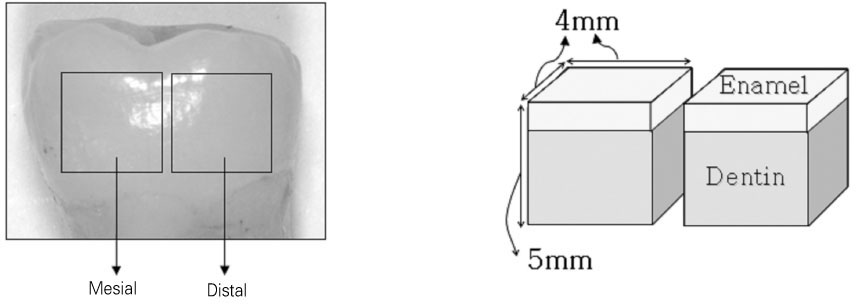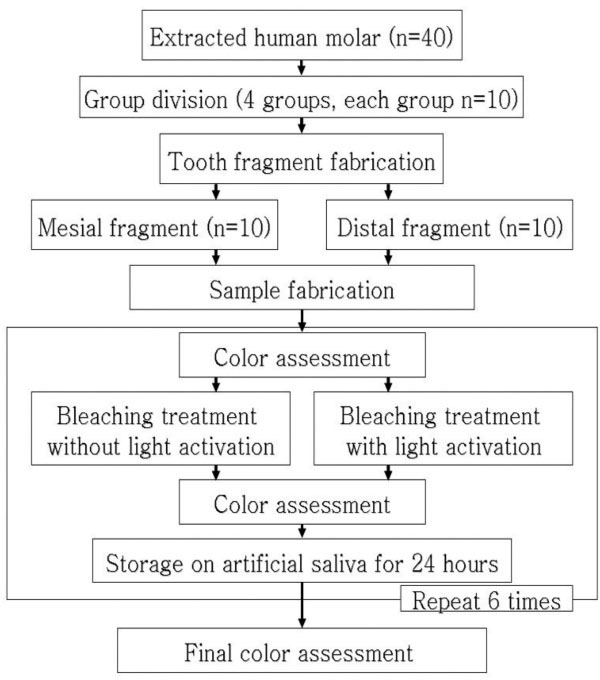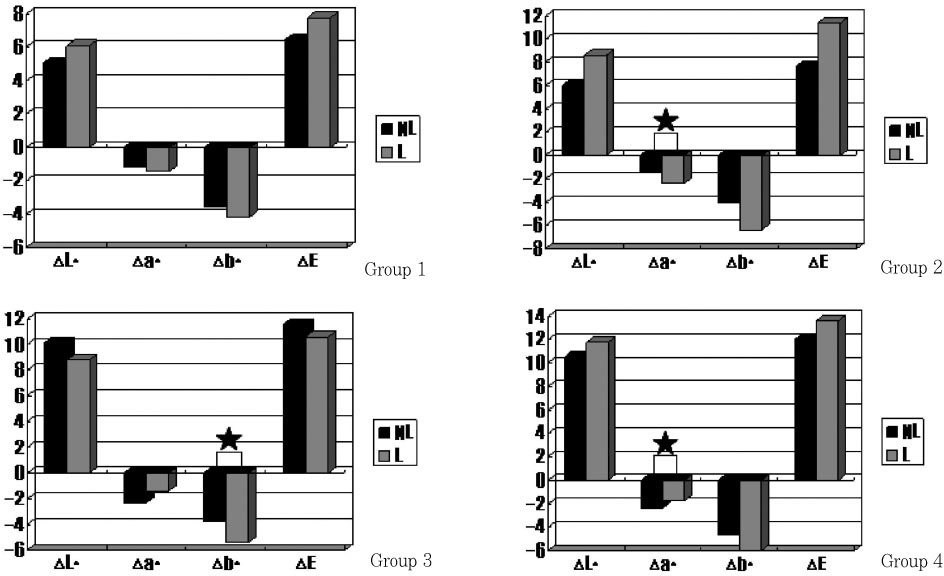J Korean Acad Conserv Dent.
2009 Mar;34(2):95-102. 10.5395/JKACD.2009.34.2.095.
Effect of the bleaching light on whitening efficacy
- Affiliations
-
- 1Department of Conservative Dentistry, College of Dentistry, Kangnung National University, Korea. drbozon@kangnung.ac.kr
- 2Department of Conservative Dentistry, College of Medicine, A-jou University, Korea.
- 3Department of Preventive Dentistry, College of Dentistry, Kangnung National University, Korea.
- KMID: 2294350
- DOI: http://doi.org/10.5395/JKACD.2009.34.2.095
Abstract
- The aim of this study was to evaluate the influence of light energy on the tooth whitening effect of bleaching agent in vitro. Extracted human mandibular molars were sectioned to 2 fragments(mesial, distal) and lingual portions of crown were used in this study. All specimens were stained using a red wine for 24 hours and immersed in artificial saliva. Specimens divided into four groups, group 1 and 2 light-activated by LumaCool (LED, LumaLite, Inc., Spring Valley, USA), group 3 and 4 light-activated by FlipoWhite2 (Plasma acr lamp, Lokki, Australia). Group 1 and 3 bleached with LumaWhite(LumaLite, Inc., Spring Valley, USA), group 2 and 4 bleached with Polaoffice(SDI, Victoria, Australia). Bleaching treatment performed during 10 minutes every 24 hours and repeated 6 times. During bleaching treatment , distal fragments was light-activated(L) but mesial fragments was not(NL). Shade assessment employed before and after bleaching treatment using spectrophotometer. The results of the change in shade was compared and analysed between NL and L by using paired-sample T test with 95% level of confidence. There were no significant differences between NL and L with a few exceptions. In group 2, a* value more change in L, in group 3, b* value more change in L, in group 4, a* value less change in L. After bleaching, L* value and DeltaE increased in all groups and the value of a* and b* decreased in all groups. Within the limitation of this test conditions, the results of this study indicate that the light energy has no obvious improving impact on the tooth whitening effect of a bleaching agent.
MeSH Terms
Figure
Cited by 2 articles
-
A clinical evaluation of safety of an office bleaching gel containing 30% hydrogen peroxide
Sin-Young Kim, Je-Uk Park, Chang-Hyen Kim, Sung-Eun Yang
J Korean Acad Conserv Dent. 2010;35(3):198-210. doi: 10.5395/JKACD.2010.35.3.198.Clinical assessment of whitening efficacy and safety of in-office tooth whitening system containing 15% hydrogen peroxide with or without light activation
Young-Suk Noh, Young-Jee Rho, Yeon-Jee Yoo, Hyang-Ok Lee, Sang-Min Lim, Hyun-Jeong Kweon, Yeun Kim, Seong-Yeon Park, Hee-Young Yoon, Jung-Hyun Lee, Chan-Hee Lee, So-Ram Oh, Kee-Yeon Kum
J Korean Acad Conserv Dent. 2011;36(4):306-312. doi: 10.5395/JKACD.2011.36.4.306.
Reference
-
1. Howe-Grant M, editor. Encyclopedia of chemical technology. 1992. vol. 4:4th ed. John Wiley and Sons.2. Chapple JA. Restoring discolored teeth to normal. Dent Cosmos. 1977. 16:449.3. Rodrigues JA, Basting RT, Serra MC, Rodrigues AL Jr. Effects of 10% carbamide peroxide bleaching materials on enamel microhardness. Am J Dent. 2001. 14:67–71.4. Gerlach RW, Zhou X. Vital bleaching with whitening strips: summary of clinical research on effectiveness and tolerability. J Contemp Dent Pract. 2001. 2:1–16.
Article5. Park YW, Park SH, Kim JW, Cho KM. The effect of tooth bleaching agents on microhardness of enamel in situ. J Korean Acad Conserv Dent. 2006. 31:470–476.
Article6. Greenwall L. Bleaching techniques in restorative dentistry-an illustrated guide. 2001. London: Martin Dunitz Ltd.7. Park ES, Seong SR, Hong ST, Kim JE, Lee ST. A clinical evaluation of a bleaching strip containing 2.9% hydrogen peroxide. J Korean Acad Conserv Dent. 2006. 31:269–281.
Article8. Jeong NY, Jin MU, Kim YK, Kim SK. Effect of vital bleaching agent on dentin bonding. J Korean Acad Conserv Dent. 2006. 31:79–85.9. Buchalla W, Attin T. External bleaching therapy with activation by heat, light or laser-A systematic review. Dent Mater. 2007. 23:586–596.
Article10. Luk K, Tam L, Hubert M. Effect of light energy on peroxide tooth bleaching. J Am Dent Assoc. 2004. 135:194–201.
Article11. Sulieman M, MacDonald E, Rees JS, Addy M. Comparison of three in-office bleaching systems based on 35% hydrogen peroxide with different light activators. Am J Dent. 2005. 18:194–197.12. Wetter NU, Barroso MC, Pelino JE. Dental bleaching efficacy with diode laser and LED irradiation: an in vitro study. Lasers Surg Med. 2004. 35:254–258.
Article13. Hein DK, Ploeger BJ, Hartup JK, Wagstaff RS, Palmer TM, Hansen LD. In-office vital tooth bleaching-what do lights add? Compend Contin Educ Dent. 2003. 24:340–352.14. Viscio D, Gaffar A, Fakhry-Smith S, Xu T. Present and future technologies of tooth whitening. Compend Contin Educ Dent Suppl. 2000. (28):S36–S43.15. Joiner A. Tooth colour: a review of the literature. J Dent. 2004. 32:Suppl. 1. 3–12.
Article16. Watts A, Addy M. Tooth discolouration and staining: a review of the literature. Br Dent J. 2001. 190:309–316.
Article17. Anusavice KJ. Philips' science of dental materials. 2003. 11th ed. St. Louis: Elsevier.18. Fay RM, Servos T, Powers JM. Color of restorative materials after staining and bleaching. Oper Dent. 1999. 24:292–296.
- Full Text Links
- Actions
-
Cited
- CITED
-
- Close
- Share
- Similar articles
-
- Clinical assessment of whitening efficacy and safety of in-office tooth whitening system containing 15% hydrogen peroxide with or without light activation
- Tooth whitening effects of manicure-type hydrogen peroxide tooth whitening gel
- Comparison of Tooth Whitening Efficacy between Gel and Strip with Light Activator
- The effect of various commercially available bleaching agents on the microshear bond strength of composite resin to enamel
- Can discolored dental composites be bleached in depth?




